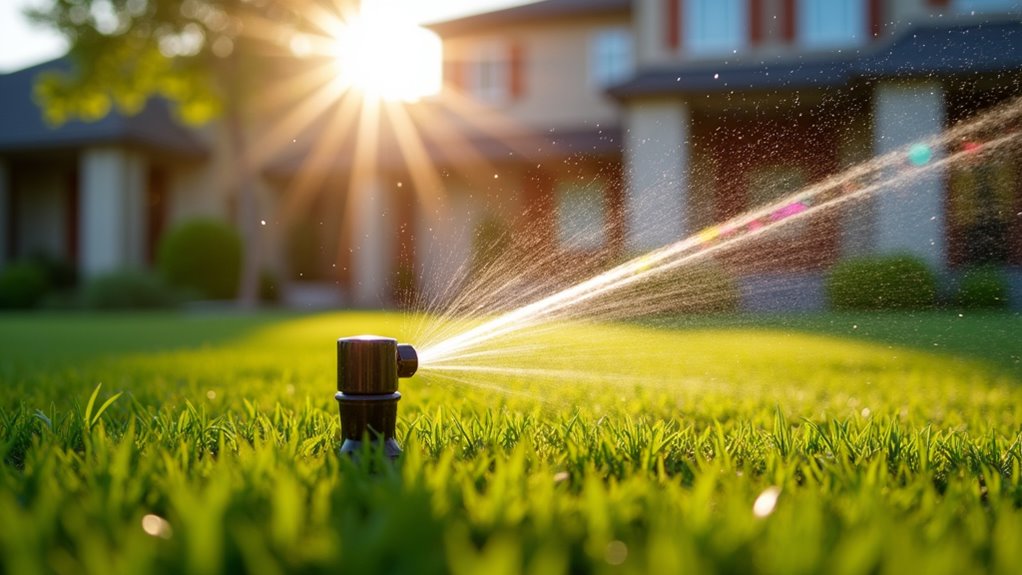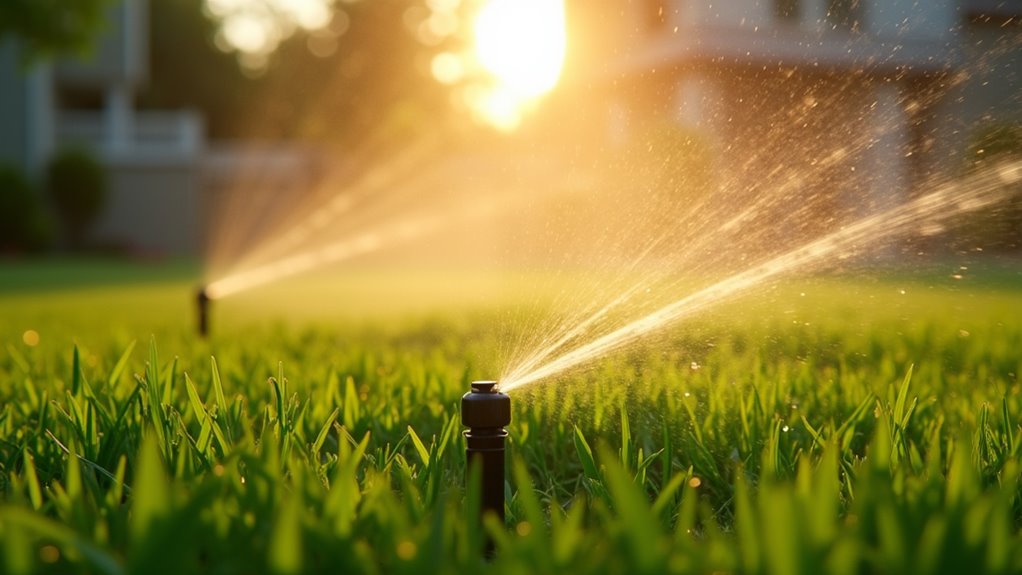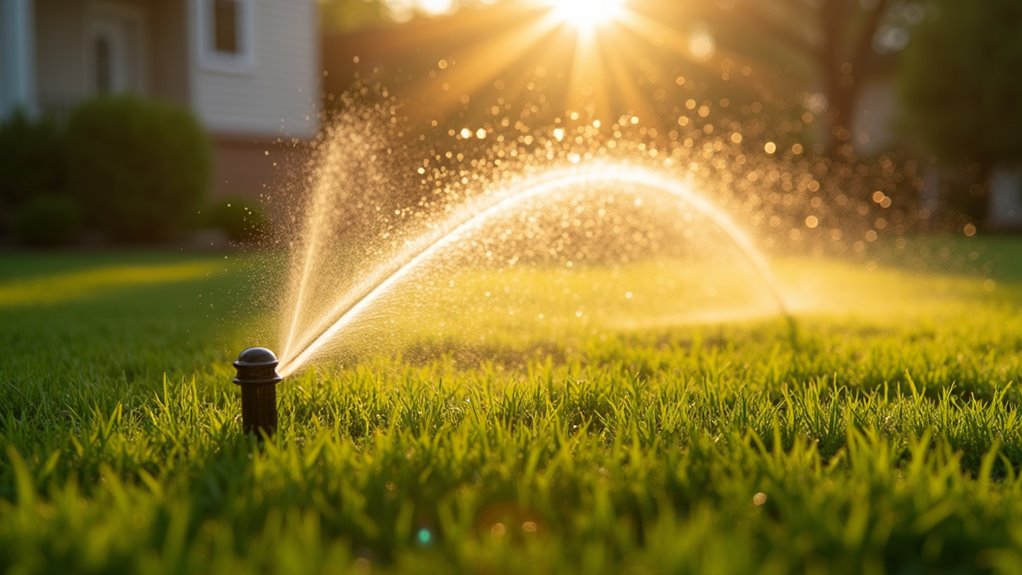The ideal time to water your lawn is between 4 AM and 10 AM when conditions optimize absorption and minimize evaporation. You’ll achieve up to 50% better water penetration during these early morning hours compared to midday watering. This timing allows grass blades to dry fully before nightfall, preventing fungal growth while promoting stronger root development. Proper morning irrigation also helps you avoid the 30% water waste that occurs during peak daylight hours. Understanding supplementary timing factors can further enhance your lawn’s health.
Why Early Morning Watering Leads to Healthier Grass
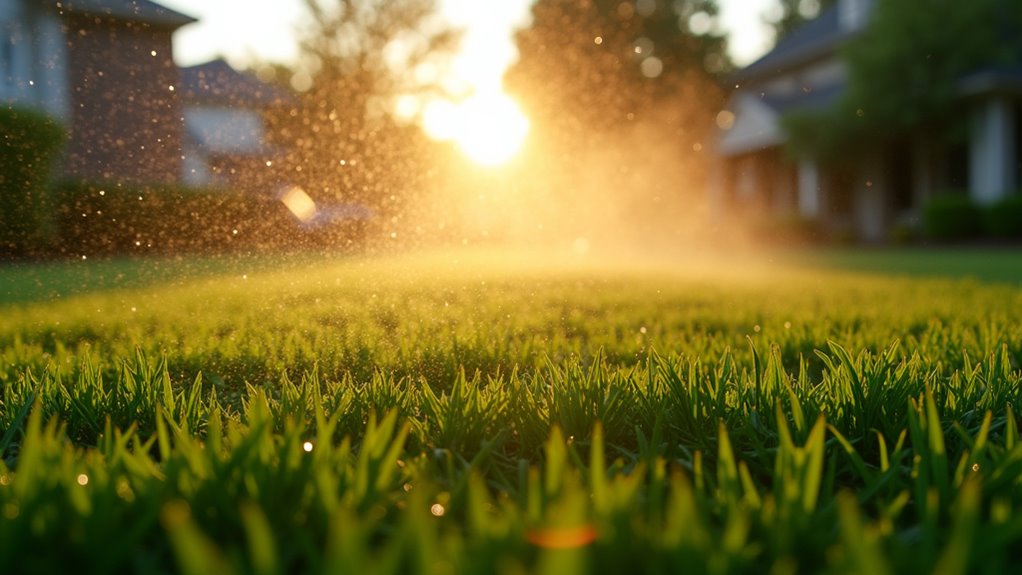
The science behind early morning lawn watering reveals vital benefits for grass health and water efficiency. When you water between 6-10 AM, you’re taking advantage of ideal conditions that optimize your lawn’s water absorption while minimizing waste.
During these early hours, you’ll find temperatures are lower and wind speeds are reduced, creating perfect conditions for water penetration into the soil. Your grass receives up to 50% more water compared to daytime watering, as morning conditions drastically reduce evaporation losses. In addition, by watering early, you’re giving your grass blades ample time to dry before nightfall, which is essential for preventing fungal growth. This timing guarantees your lawn fully utilizes the water it receives, promoting stronger root development and overall healthier grass growth.
Understanding Your Lawn’s Water Requirements
Since every lawn has unique characteristics, determining your grass’s precise water needs requires understanding several key variables. Your lawn’s water requirements depend primarily on grass type, soil composition, and local climate conditions.
| Factor | Impact | Water Adjustment |
|---|---|---|
| Cool-Season Grass | Higher water need | Increase 25-30% |
| Warm-Season Grass | Lower water need | Standard 1-2″ weekly |
| Sandy Soil | Fast drainage | Water more frequently |
| Clay Soil | Slow drainage | Reduce frequency |
| Weather Changes | Affects absorption | Adjust accordingly |
You’ll need to monitor your lawn’s moisture levels carefully, as both overwatering and underwatering can damage your grass. Most lawns require 1-2 inches of water weekly, but you should adjust this based on rainfall, temperature, and soil conditions. Watch for signs of water stress and modify your irrigation schedule to maintain ideal growth.
Signs Your Lawn Needs Watering
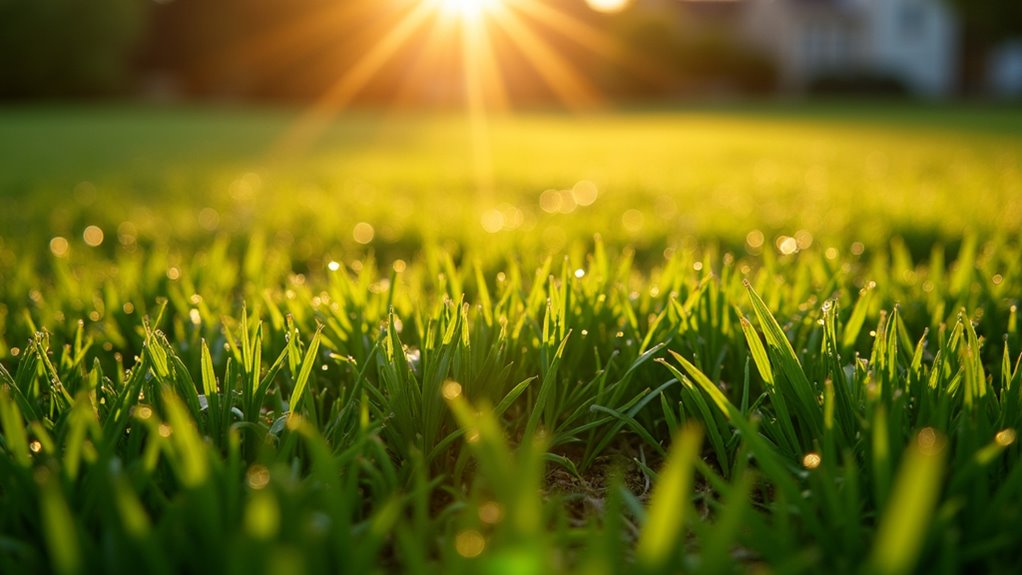
Your lawn communicates its thirst through distinct color transformations, shifting from a vibrant green to a dull blue-gray hue when water levels are insufficient. You’ll notice these changes initial in high-traffic areas, where footprints remain visible longer than usual instead of springing back quickly. The grass blades’ slow recovery from foot traffic, combined with their muted coloration, serves as your lawn’s scientific indicator that it’s time to water.
Grass Color Changes
Several visual indicators can help you determine when your lawn needs water, with color changes being one of the most reliable signs. When your grass begins to lose its vibrant green appearance and takes on a grayish or dull green hue, it’s signaling a need for irrigation.
You’ll notice that dry grass exhibits distinct characteristics beyond just color variation. The blades will appear less resilient, failing to spring back after you’ve walked across them. Likewise, if you observe your footprints remaining visible in the grass for longer than usual, this indicates drought stress. The grass blades may also start curling or wilting, which is your lawn’s way of conserving moisture during dry conditions. These color and texture changes serve as early warning signs that you should water your grass before more severe damage occurs.
Footprint Recovery Test
A simple yet reliable method to assess your lawn’s hydration needs is the footprint recovery test. When you walk across your grass, observe how quickly the blades return to their upright position. If your footprints remain visible for longer than a few seconds, it’s a clear indication that your lawn is dehydrated and requires watering.
In a well-hydrated lawn, grass blades naturally spring back after being compressed. However, when your lawn is water-stressed, the blades lack sufficient moisture to maintain their cellular rigidity. You’ll notice the grass appears dull and takes on a grayish-green hue. This loss of resilience means the grass can’t quickly recover from the pressure of footsteps. By regularly performing this footprint test, you’ll be able to determine precisely when your lawn needs irrigation.
Common Mistakes in Lawn Watering Timing
Two critical timing errors can sabotage your lawn’s health: watering at midday wastes water through rapid evaporation, while nighttime irrigation creates ideal conditions for fungal diseases to develop. You’ll lose up to 30% of water to evaporation during peak afternoon hours when the sun is strongest and temperatures are highest. Watering in the evening or at night keeps grass blades wet for extended periods, creating a humid microenvironment that promotes harmful fungal growth and multiple turf diseases.
Nighttime Watering Risks
Despite the convenience of nighttime watering, this practice poses significant risks to your lawn’s health and can lead to numerous problems. When you water at night, moisture remains on grass blades for extended periods due to the absence of sunlight and wind, creating ideal conditions for fungal disease development.
You’ll find that nighttime watering can result in water pooling on your lawn, which furthermore encourages mosquito breeding but also increases the risk of mold and mildew formation. The lack of natural drying mechanisms during dark hours means your grass stays wet longer than it should. Besides, if you’re watering in the late evening, your lawn won’t have sufficient time to dry before temperatures drop, making it even more susceptible to diverse fungal infections. Instead, you’ll achieve better results by watering during early morning hours.
Midday Moisture Loss
Many homeowners mistakenly water their lawns during peak daylight hours, leading to substantial water waste and reduced irrigation efficiency. When you irrigate during high temperatures, wasteful evaporation can claim up to 50% of the water before it can soak into the soil where your grass needs it most.
- Direct sunlight and wind greatly increase moisture loss, preventing water from reaching the root zone effectively
- Your lawn’s absorption rate decreases enormously during midday hours, making irrigation less effective
- Water droplets can act like magnifying glasses in intense sunlight, potentially causing additional stress to grass blades
- The combination of heat and wind creates conditions where water disperses into the atmosphere rather than penetrating the soil
Understanding these factors helps you avoid inefficient watering practices and conserve this valuable resource while maintaining a healthy lawn.
Adjusting Water Schedules for Different Seasons

Successful lawn maintenance requires precise seasonal adjustments to your watering schedule. The time of day for watering your lawn varies greatly with weather conditions and seasonal changes. You’ll need to adapt your approach throughout the year to maximize water absorption and minimize waste.
| Season | Best Watering Time |
|---|---|
| Spring | Early Morning |
| Summer | Early Evening |
| Fall | Afternoon |
| Winter | Midday (Less Frequent) |
| Emergency* | As Needed |
During spring, water in early morning when soil absorption rates peak. Switch to evening watering in summer to reduce evaporation losses. Fall watering is most effective in the afternoon when temperatures begin dropping. Winter requires less frequent but deep watering sessions, as dormant grass has minimal moisture needs. Monitor local precipitation patterns and adjust accordingly to maintain ideal soil moisture levels.
*Emergency watering may be necessary during extreme heat or drought conditions.
How Weather Conditions Impact Watering Times
Weather conditions play a crucial role in determining the best times for lawn irrigation. Your watering schedule needs to adapt to changing weather conditions to optimize absorption and minimize water waste.
- The time of day significantly affects evaporation rates. Early morning watering takes advantage of cooler temperatures and lower wind speeds, allowing water to permeate deeper into the soil.
- During hot, dry weather conditions, you’ll need to adjust your watering frequency. In these situations, consider splitting watering sessions between early morning and late afternoon.
- You’ll want to avoid midday watering when temperatures peak, as excessive evaporation can waste up to 30% of water before it reaches the roots.
- Monitor weather forecasts to anticipate changes. If rain is predicted, adjust your irrigation schedule accordingly to prevent overwatering and potential fungal growth.
Best Practices for Different Grass Types
Different grass types require distinct watering approaches to maintain ideal health and appearance. If you’ve got cool-season lawns like fescue or bluegrass, you’ll need to provide 1-2 inches of water weekly through your watering system. Warm-season varieties such as bermuda and zoysia are more drought-tolerant, requiring only 1/2 to 1 inch per week.
Your soil composition plays a vital role in determining irrigation frequency. Sandy soils need more frequent watering, while clay soils retain moisture longer. When establishing new lawns, you’ll need to maintain consistent moisture in the top layer regardless of grass type. Consider your local climate and adjust your watering schedule accordingly. By matching your irrigation practices to your specific grass type, you’ll promote deeper root growth and a healthier lawn in general.
Smart Irrigation Technologies and Timing
Modern irrigation technology has revolutionized lawn care through sophisticated automation and precision control systems. You’ll find that smart irrigation controllers integrate seamlessly with weather data and soil moisture sensors to maximize your watering time and resource efficiency.
- Smart controllers automatically adjust your watering schedule by analyzing real-time weather conditions and soil moisture levels, ensuring your lawn receives precisely what it needs.
- Rain and wind sensors pause irrigation during unfavorable conditions, preventing water waste and promoting better absorption.
- Pressure-regulating sprinkler heads maintain ideal water distribution while minimizing misting and evaporation losses.
- Drip irrigation systems deliver water directly to root zones, reducing waste by up to 30-50% compared to traditional sprinklers.
You can monitor and control these systems remotely through smart home platforms, giving you unprecedented control over your lawn’s hydration needs.
Water Conservation Strategies for Lawn Care
Implementing effective water conservation strategies can drastically reduce your lawn’s water consumption while maintaining its health and appearance. You’ll optimize efficiency by installing a programmable sprinkler system that waters deeply and infrequently during preferred morning hours, allowing time to dry before nightfall. Monitor your grass for signs of drought stress, such as blue-gray coloring or persistent footprints.
| Strategy | Benefit | Implementation |
|---|---|---|
| Rain Barrel | Free Water Source | Collect from Gutters |
| Smart Sprinklers | Precise Coverage | Align Away from Pavement |
| Moisture Monitoring | Prevents Waste | Check for Footprints |
Prevent water waste by immediately stopping irrigation when you notice runoff. Consider supplementing your watering routine with captured rainwater, which provides a sustainable alternative to municipal sources. Proper sprinkler alignment guarantees water reaches your grass rather than hard surfaces, maximizing every drop used.
Frequently Asked Questions
What Is the Best Time of Day to Water Your Lawn?
You’ll achieve the best lawn watering results during the early morning hours, specifically between 6 a.m. and 10 a.m. This timing allows water to penetrate deeply while minimizing evaporation. While cool evening times might seem suitable, they can promote fungal growth due to prolonged moisture. You should avoid midday heat when water evaporates quickly, making irrigation less effective. Early morning watering guarantees maximum absorption and helps prevent disease development in your grass.
What Is the 1/2/3/2:1 Lawn Watering Technique?
The 1/2/3/2:1 technique is a water conservation strategy that optimizes your irrigation system through timed cycles. You’ll start with one hour of watering, followed by a two-hour rest, then three hours of watering, another two-hour break, and finish with one final hour. This methodical approach augments soil moisture levels by allowing water to penetrate deeply between intervals, preventing runoff and promoting efficient absorption, especially in clay-heavy soils.
Is 20 Minutes Too Long to Water Grass?
Twenty minutes isn’t automatically too long to water grass, but you’ll need to monitor your soil moisture levels carefully. Your lawn’s specific needs depend on your soil type, grass variety, and climate. You can optimize water conservation methods by breaking up watering into shorter sessions and ensuring proper sprinkler placement. If you’re seeing runoff or puddles before the 20-minute mark, you should reduce your watering duration to prevent oversaturation and potential root damage.
Is It Good to Water Grass at 3pm?
You shouldn’t water your grass at 3pm, as mid-afternoon irrigation is highly inefficient. During this time, you’ll lose significant amounts of water to evaporation, and the intense sunlight can actually stress your grass. Instead, you’ll get better results with early evening watering or nighttime lawn soaking. These later times allow water to penetrate deeply into the soil, promoting stronger root development and healthier grass growth in general.

